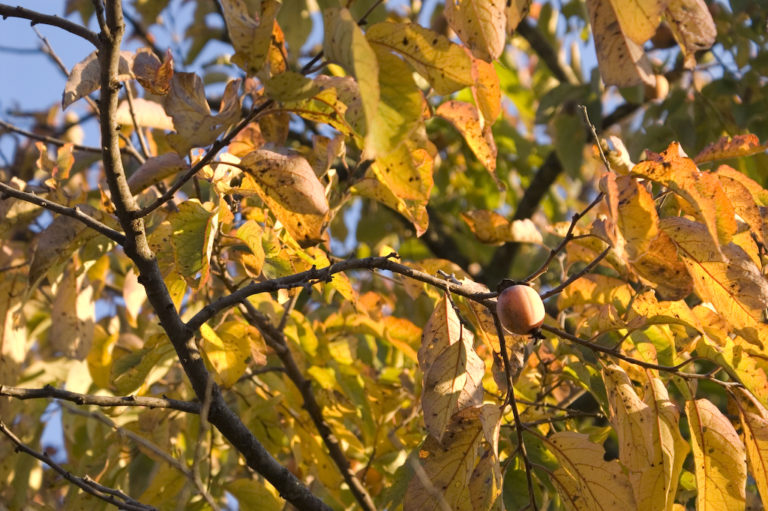Eastern persimmon is a lovely small- to medium-sized tree (up to sixty feet tall x thirty feet in spread) with lustrous foliage, dark green in summer and rich golden in fall, and beautiful bark. A member of the Ebony family, it is prized for its high quality, hard heartwood (used to be used for golf club heads) as well as for its abundant, sweet fruit. It is tolerant of a wide variety of growing conditions, and is found in deep, moist alluvial soils of stream bottoms, and also in drier, upland sites of the Piedmont and upper Coastal Plain. The fruit is mouth-puckering tart until the first frost, after which it becomes delicious. The sweet fruits are eaten by a great many birds and mammals as well as by people, and the foliage supports many insects and serves as host for native caterpillars, including the breathtaking luna moth caterpillar. So it is a great food source for people AND a great wildlife plant. Grow it in full sun or part shade, away from sidewalks, and learn to make tantalizing, delicious persimmon-based culinary treats.
NURSERY HOURS
Wednesday: 10-4 Thursday: 10-6 Friday-Saturday: 10-4 Sunday: 12-4
Diospyros virginiana

Key Info
Scientific Name: Diospyros virginiana L.
Common Names: Common Persimmon, Eastern Persimmon, American Persimmon, Possumwood, American Ebony, White Ebony, Bara-bara, Boa-wood, Butterwood, Possum Apples, Sugar-plum
Family Names: Ebenaceae (Ebony Family)
Plant Type: Tree / Shrub
Leaf Retention: Deciduous
Flower Color: White with yellow, inconspicuous
Special Characteristics: Fragrant flowers, Edible fruit (in jams), Tolerates urban pollution, Rhizomatous or stoloniferous, Tolerates flooding, Tolerates drought, Attracts bees, Good wildlife cover/habitat, Attracts butterflies, Interesting bark, Excellent timber, Good fall color, Excellent wildlife food, Attracts birds
Additional Info
Habit: Upright tree with dominant main trunk, branches often pendulous, a rounded, oval crown, deeply furrowed, blocky bark and a deep, woody taproot. Is colonial in favorable conditions, stoloniferous.
Height: 35'-70'; much taller in the southwest portion of its range, in LA, TX, AR
Spread: 25'-30'
Soil Conditions: Moist to dry, acid to slightly alkaline pH, clay-loam, loam, silt, sand, and rocky material
Leaves: Leaves are alternate, simple, oval, glossy, up to 6" long x 2" across, with smooth margins and pointed tip. They are pinnately veined, medium to dark green and glabrous above, lighter in color and slightly pubescent below, Leaves can turn orange or scarlet in fall, more often golden.
Flowers (or reproductive structures: Persimmon trees are dioecious. Both staminate and pistillate flowers occur on the current season's growth. They are small (male smaller than female), fragrant, urn-shaped, and white with yellow, reflexed lobes. They are visually inconspicuous, but their fragrance attracts a host of pollinators. The calyx of the female flower persists and grows prominent as the fruit matures.
Fruit: Estimates for first fruiting range from 6 to 10 years. Immature fruits are greenish, the flesh very astringent. Mature fruits (after first frost) are more or less round, 1-3" across, in shades of orange, containing sweet, fleshy pulp and up to 8 flattened seeds. Technically a berry.
Natural Distribution: Dry woods, old fields, clearings of the South Atlantic and Gulf states.
USDA Hardiness Zone: 4 to 9
USDA Wetland Indicator Status in NC: FAC
Pollination: Bees, butterflies, other insects; sometimes female flowers can self-pollinate
Wildlife Connections: Flowers attract very large number of honey bees, butterflies, moths; the foliage supports caterpillars and is larval host for the luna moth; fruits are an important source of fall and winter food for many mammals, including deer, opossum, deer and bears (Cullina).
Propagation: By seeds or root cuttings.
